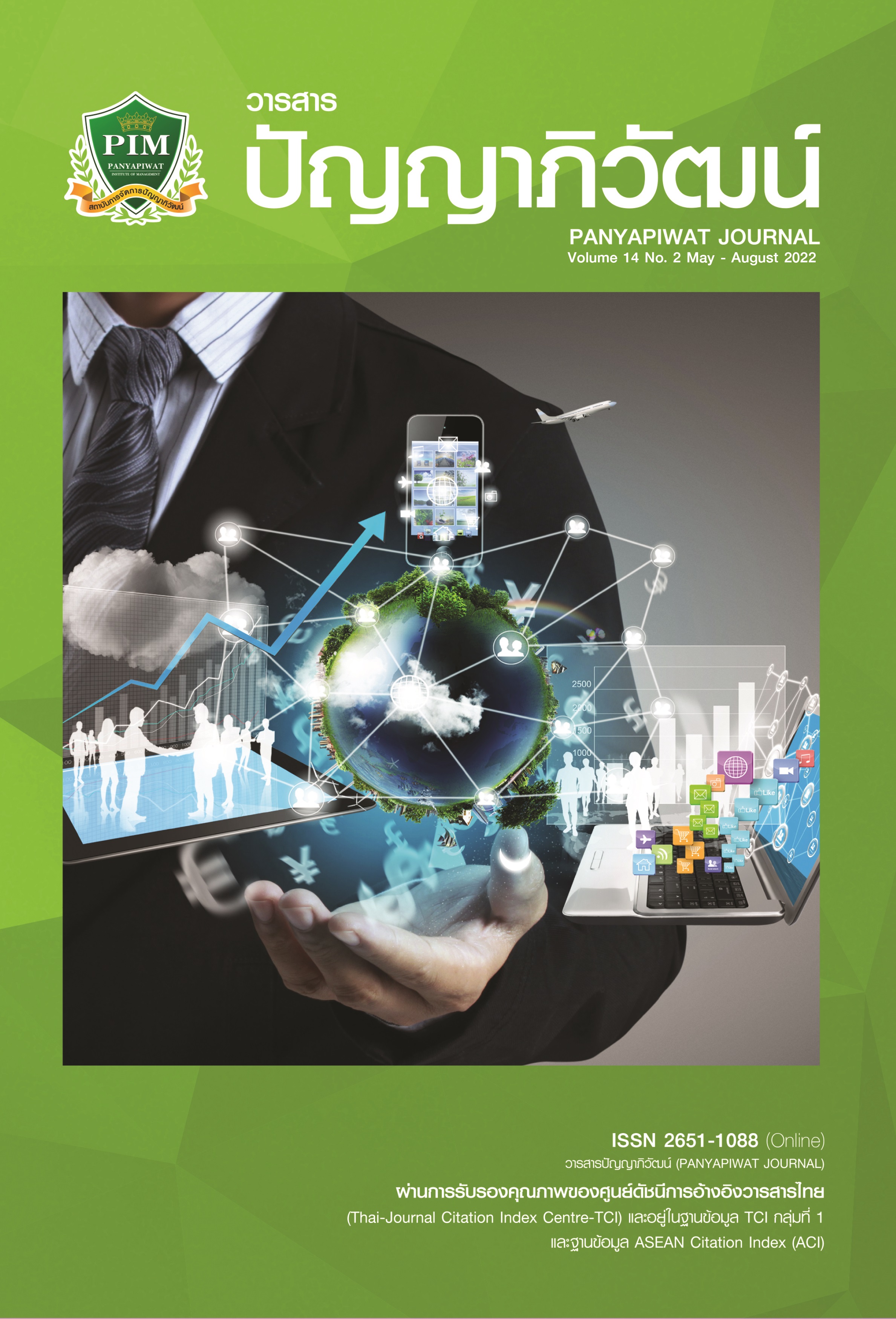BEHAVIORAL DETERMINANTS ON ACCEPTANCE OF THAI E-MARKETPLACE
Main Article Content
บทคัดย่อ
The role of e-marketplace in Thailand is becoming increasingly important in Thai people’s daily life because it is convenient and fast. As a result, online commerce has grown rapidly and simultaneously. This research was aimed to (1) investigate factors that affect the users’ behavioral intentions for using e-marketplace by using the Extended Technology Acceptance Model (TAM) with customized external variables and (2) study which influencing factors are the key factors that make users use e- arketplace regularly.
An online survey questionnaire had been distributed to 416 people who were familiar with e-marketplace platforms, and the research data were analyzed with the use of the partial least square structural equation modeling (PLS-SEM). In the research findings, it was found that (1) sale promotion and game mechanic factors had significant effects on perceived usefulness, while sales promotion factor and family and friends factor had significant effects on perceived ease of use and (2) both perceived usefulness and perceived ease of use also had statistically significant effect on behavioral intentions of the users for the use of e-marketplace. In the conclusion, this paper presented the important administrative recommendations for creating satisfaction of e-marketplace users that would create higher acceptance for using e-marketplace in Thailand.
Article Details

อนุญาตภายใต้เงื่อนไข Creative Commons Attribution-NonCommercial-NoDerivatives 4.0 International License.
“ข้าพเจ้าและผู้เขียนร่วม (ถ้ามี) ขอรับรองว่า บทความที่เสนอมานี้ยังไม่เคยได้รับการตีพิมพ์และไม่ได้อยู่ระหว่างกระบวนการพิจารณาลงตีพิมพ์ในวารสารหรือแหล่งเผยแพร่อื่นใด ข้าพเจ้าและผู้เขียนร่วมยอมรับหลักเกณฑ์การพิจารณาต้นฉบับ ทั้งยินยอมให้กองบรรณาธิการมีสิทธิ์พิจารณาและตรวจแก้ต้นฉบับได้ตามที่เห็นสมควร พร้อมนี้ขอมอบลิขสิทธิ์บทความที่ได้รับการตีพิมพ์ให้แก่สถาบันการจัดการปัญญาภิวัฒน์หากมีการฟ้องร้องเรื่องการละเมิดลิขสิทธิ์เกี่ยวกับภาพ กราฟ ข้อความส่วนใดส่วนหนึ่งและ/หรือข้อคิดเห็นที่ปรากฏในบทความข้าพเจ้าและผู้เขียนร่วมยินยอมรับผิดชอบแต่เพียงฝ่ายเดียว”
เอกสารอ้างอิง
Ab Hamid, M. R., Sami, W., & Sidek, M. M. (2017). Discriminant validity assessment: Use of fornell & larcker criterion versus HTMT criterion. Journal of Physics: Conference Series, 890(2017), 012163. https://doi.org/10.1088/1742-6596/890/1/012163
Adawi, M., Bragazzi, N., Villar, L. A., Boada-Grau, J., Vigil-Colet, A., Yildirim, C., Puente, G. D., & Watad, A. (2018). Translation and validation of the Nomophobia questionnaire (NMP-Q) in the Italian language: Insights from factor analysis. JMIR mHealth and uHealth, 6(1), e24. https://doi.org/10.2196/mhealth.9186
Ajibade, P. (2018). Technology acceptance model limitations and criticisms: Exploring the practical applications and use in technology-related studies, mixed-method, and qualitative researches. Library Philosophy & Practice in 2018.
Ajzen, I. (1991). The theory of planned behavior. Organizational Behavior and Human Decision Processes, 50(2), 179-211. https://doi.org/10.1016/0749-5978(91)90020-T
Ajzen, I., & Fishbein, M. (1980). Understanding attitudes and predicting social behavior. Prentice-Hall.
Alduaij, M. (2019). Employing the technology acceptance model to explore the trends of social media adoption and its effect on perceived usefulness and perceived ease of use. Journal of Information Technology Management, 11(2), 129-143.
Aparicio, M., Carlos J., C., & Moises, R. (2021). Gamification and reputation: Key determinants of e-commerce usage and repurchase intention. Heliyon, 7(3), 1-14. https://doi.org/10.1016/j.heliyon.2021.e06383
Charoenpiriyaves, K. (2020). Online marketing strategies & older population [Master’s thesis]. Mahidol University. https://archive.cm.mahidol.ac.th/handle/123456789/3687
Davis, F. D. (1985). A technology acceptance model for empirically testing new end-user information systems: Theory and results. Sloan School of Management: Massachusetts Institute of Technology.
Davis, F. D. (1989). Perceived usefulness, perceived ease of use, and user acceptance of information technology. MIS Quarterly, 13(3), 319-340.
Deelers, S., & Rattanapongpun, S. (2018). The factors that influence consumer with purchasing decisions process of e-commerce market niches. Veridian E-journal Silpakron University, 11(1), 2303-2323.
Edgar, Dunn and Company. (2019). E-commerce payments trends. Jpmorgan. https://www.jpmorgan.com/merchant-services/insights/reports/thailand
Gefen, D., Karahanna, E., & Straub, D. (2003). Trust and tam in online shopping: An Integfated model. MIS Quarterly, 2, 51-93.
Hair, J. F. Jr., Matthews, L., Matthews, R., & Sarstedt, M. (2017). PLS-SEM or CB-SEM: Updated guidelines on which method to use. International Journal of Multivariate Data Analysis, 1(2), 107-123. https://doi.org/10.1504/IJMDA.2017.087624
International Trade Administration. (2021, August 16). E-commerce. Trade. https://www.trade.gov/country-commercial-guides/thailand-ecommerce#:~:text=According%20to%20a%20JP%20Morgan,regional%20forerunners%20for%20mobile%20commerce
Kamboj, S., Rana, S., & Drave, V. A. (2020). Factors driving consumer engagement and intentions with gamification of mobile apps. Journal of Electronic Commerce in Organizations (JECO), 18(2), 17-35. https://doi.org/10.4018/JECO.2020040102
Lin, Z., Zhen, S., Xiaotong, L., & Yuqiang, F. (2021). Gamification and online impulse buying: The moderating effect of gender and age. International Journal of Information Management, 61, 102267. https://doi.org/10.1016/j.ijinfomgt.2020.102267
Murtaza, M., Gupta, V., & Carroll, R. (2004). E-marketplaces and the future of supply chain management: Opportunities and challenges. Business Process Management Journal, 10(3), 325-335.
Naovarat, S., & Juntongjin, P. (2015). Factor that affecting success of e-marketplace in Thailand. In 2015 International Conference on Computer Science and Information Systems (pp. 24-25). ICCSIS-15.
Nigam, A., Dewani, P., & Behl, A. (2020). Exploring deal of the day: An e-commerce strategy. Benchmarking: An International Journal, 27(10), 2807-2830. https://doi.org/10.1108/BIJ-03-2020-0129
Nunnally, J. (1978). Psychometric theory. McGraw-Hill.
Pratama, R. I., Megadini, D. D., & Kusriandini, T. (2019). Effect of perceived ease of use, word-of-mouth communication, and brand image on decision to use lazada e-commerce services. International Journal of Multicultural and Multireligious Understanding, 6, 173-186. https://doi.org/10.18415/ijmmu.v6i1.533
Schuldt, J., & Friedemann, S. (2017). The challenges of gamification in the age of Industry 4.0: Focusing on man in future machine-driven working environments. IEEE.
Sebastian, D., Dan, D., Rilla, K., & Lennart, N. (2011). From game design elements to gamefulness: Defining “Gamification”. In The 15th International Academic MindTrek Conference: Envisioning Future Media Environments (pp. 9-15). https://doi.org/10.1145/2181037.2181040
Siritida, P. N. (2018, January 30). Permission for Commercial Banks and companies within financial business group to provide e-Marketplace Platform. BOT. https://www.bot.or.th/Thai/PressandSpeeches/Press/News2561/n0761t_annex.pdf
Solomon, Y., Warin, J., & Lewis, C. (2002). Helping with homework? Homework as a site of tension for parents and teenagers. British Educational Research Journal, 28(4), 603-622. https://doi.org/:10.1080/0141192022000005850a
Standing, S., & Standing, C. (2015). Service value exchange in B2B electronic marketplaces. Journal of Business & Industrial Marketing, 30(6), 723-732.
Strong, C., & Eftychia, S. (2006). The influence of family and friends on teenage smoking in Greece: Some preliminary findings. Marketing Intelligence & Planning, 24(2), 119-126.
Sundjaja, A., M., Arisanto, G. V., & Fatimah, S. (2020). The Determinant factors of e-commerce usage behavior during flash sale program. CommIT Journal: Communication and Information Technology, 14, 65-72. https://doi.org/10.21512/commit.v14i2.6582
Vongurai, R. (2021). Factors influencing consumer attitudes and purchase intentions of flash sale through online shopping platforms. Journal of Humanities and Social Sciences Nakhon Phanom University, 11(1), 1-20.
Widarto, R., Hatta, I. H., & Evi, T. (2019). Determinants of trust and customer loyalty on C2C e-marketplace in Indonesia. International Journal of Civil Engineering and Technology, 10(3), 119-129. https://doi.org/10.34218/IJM.10.3.2019.012


